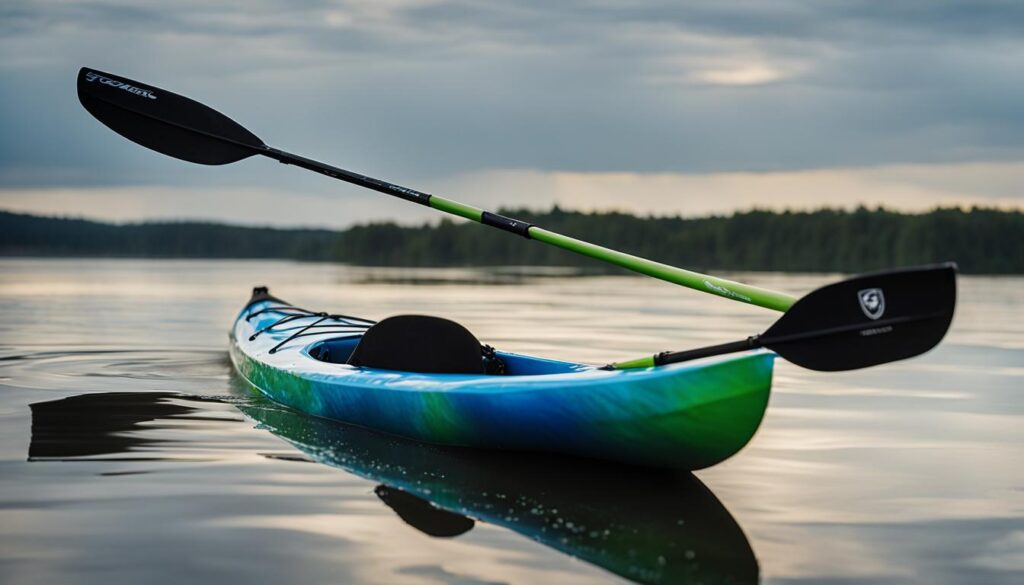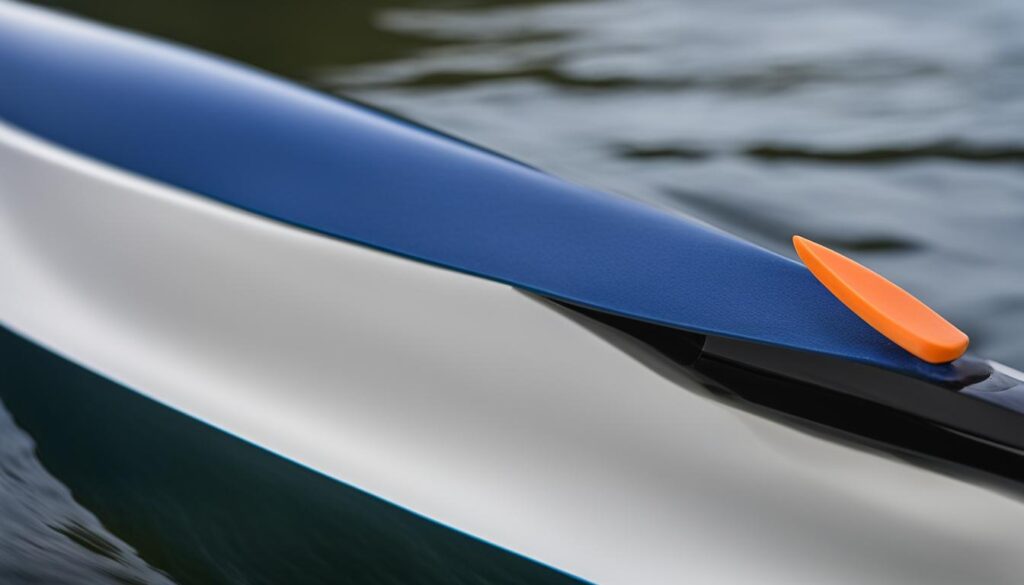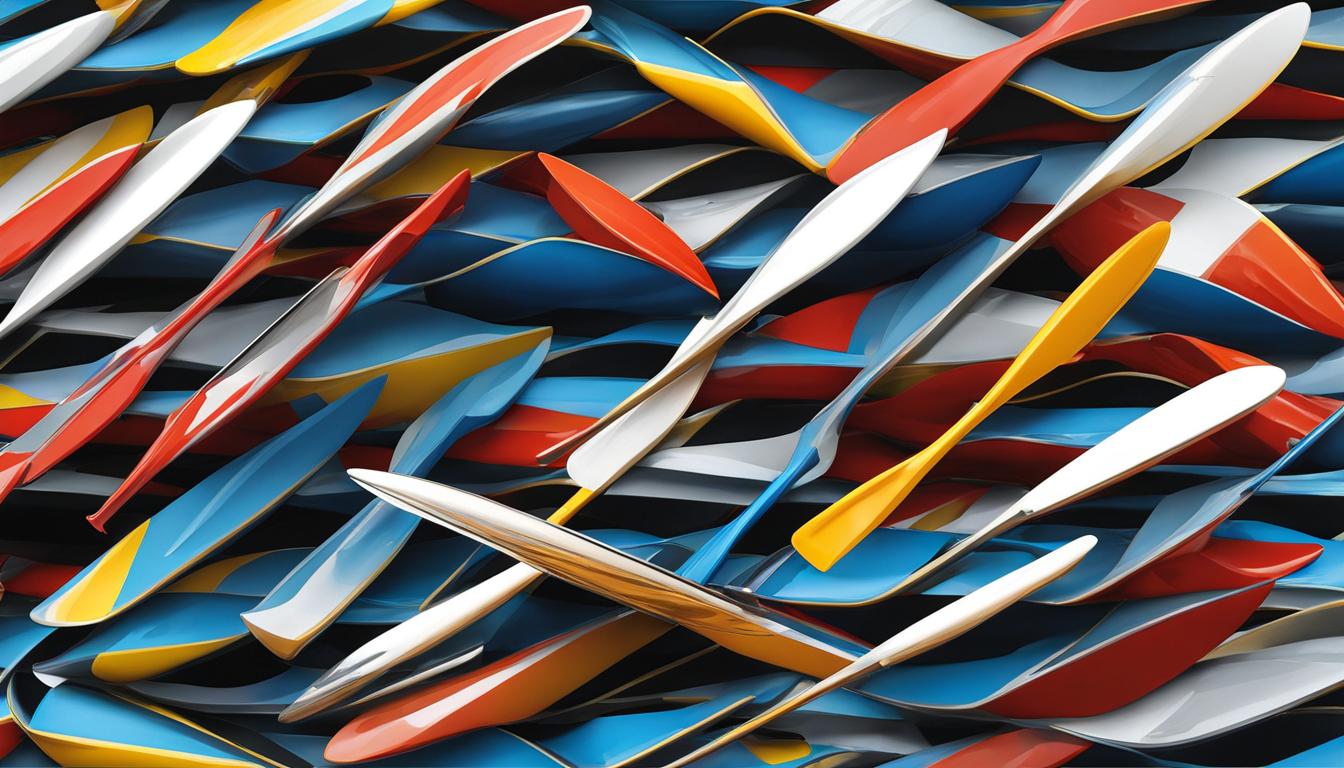Blade shape is a crucial factor that can significantly impact your kayaking experience. The design of your kayak paddle’s blade can affect its efficiency, performance, and your overall control on the water. Understanding the different blade shapes and choosing the right one for your paddling style is essential to enhance your enjoyment and maximize your efficiency.
Key Takeaways:
- Blade shape plays a crucial role in kayak paddling efficiency and performance.
- There are three main aspects to consider when it comes to blade shape: blade outline, lengthwise curve, and cross-section.
- Blade outline can be symmetrical or asymmetrical, offering different levels of boat control.
- Lengthwise curve can be flat or curved, with curved blades providing an early catch in the water.
- Blade cross-sections can be flat, spooned, dihedral, or winged, each with its own advantages and disadvantages.
By selecting the right blade shape for your kayaking adventures, you can optimize your control, power, and maneuverability. Whether you’re a beginner looking for forgiveness or an experienced paddler seeking enhanced boat control, understanding blade shape is key to unlocking your paddling potential.
Understanding Blade Outline
Blade outline is an important factor to consider when choosing a kayak paddle. It refers to the shape of the blade when viewed flat on. There are two main types of blade outline: symmetrical and asymmetrical.
Symmetrical blades have two halves that are mirror images of each other, while asymmetrical blades have two sides that are different from each other. The choice between symmetrical and asymmetrical blades depends on your paddling style and preferences.
Asymmetrical blades are known for offering better boat control, especially for aggressive paddlers. They provide a more efficient stroke and enable you to maneuver your kayak with precision. On the other hand, symmetrical blades are more forgiving and suitable for less aggressive paddlers. They provide stability and are easier to handle for beginners.
When choosing a blade outline, consider your skill level, paddling style, and the type of water you’ll be paddling in. It’s important to find a blade shape that suits your needs and enhances your kayaking experience.
| Blade Outline | Advantages | Disadvantages |
|---|---|---|
| Symmetrical | Easier for beginners | Less boat control |
| Asymmetrical | Better boat control | May require more skill |
Exploring Lengthwise Curve
The lengthwise curve of a kayak paddle blade refers to the shape of the blade when viewed from the side. This aspect of blade design plays a crucial role in the performance and efficiency of paddling. There are two main types of lengthwise curve: flat and curved blades.
Flat blades are typically more forgiving and suitable for beginners. They offer stability and ease of control, making them a great choice for those who are just starting out or prefer a more relaxed paddling style. Flat blades are less likely to catch on the water, allowing for smoother strokes and reducing the risk of fatigue.
On the other hand, curved blades provide an early catch in the water, enabling paddlers to generate more power with each stroke. The curved shape allows for a quicker engagement of the blade, resulting in efficient propulsion and increased speed. Curved blades are commonly used by experienced paddlers and those who prioritize speed and performance.
It’s important to note that the choice between flat and curved blades ultimately depends on individual preference and paddling style. Some paddlers may prefer the stability and ease of control offered by flat blades, while others may prioritize the power and speed provided by curved blades. Experimenting with different blade designs is key to finding the one that best suits your needs and enhances your paddling experience.
Comparison Table: Flat Blades vs. Curved Blades
| Aspect | Flat Blade | Curved Blade |
|---|---|---|
| Stability | High | Medium |
| Control | High | Medium |
| Catch | Delayed | Early |
| Power | Low | High |
| Speed | Medium | High |
As seen in the comparison table, flat blades offer higher stability and control while sacrificing some power and speed. On the other hand, curved blades provide an early catch, higher power, and increased speed but may offer slightly lower stability and control. Ultimately, the choice between flat and curved blades depends on your skill level, paddling goals, and personal preferences.
Remember to consider the type of kayaking you plan to do and the specific conditions you’ll be paddling in. Whether you opt for flat or curved blades, finding the right lengthwise curve can improve your efficiency and overall enjoyment on the water.

Understanding Blade Cross Section
Blade cross section plays a crucial role in determining the performance and functionality of a kayak paddle. There are several different types of blade cross sections, each with its unique characteristics and advantages. By understanding the differences between these cross sections, you can choose the blade that best suits your paddling style and goals.
Flat Blade
“The flat blade cross section is the simplest design, with a flat surface when viewed from the cut edge. This design provides a balance between power and maneuverability, making it suitable for various paddling conditions. The flat shape allows for easy entry and exit from the water, making it forgiving for beginners. However, it may not be as efficient in creating lift or preventing flutter compared to other blade shapes.”
Spoon Blade
“The spoon blade cross section has a curved surface reminiscent of a spoon. This shape allows for a more efficient catch in the water, providing increased power and acceleration. The curved shape also helps to guide water flow along the blade for better stability and control. Spoon blades are commonly used by experienced paddlers who require high-performance blades for aggressive paddling.”
Dihedral Blade
“The dihedral blade cross section features two power faces that are angled in a “V” shape. This design helps to guide water flow and reduce flutter, providing a smoother and more controlled stroke. Dihedral blades are particularly useful for stability and efficient forward paddling. However, they may require more skill to maneuver compared to other blade shapes.”
Wing Blade
“The wing blade cross section resembles the shape of an airplane wing, with a curved surface and an asymmetrical design. This unique shape creates lift, allowing for increased efficiency and speed. Wing blades are commonly used in competitive kayaking and require a specific technique and paddling style to optimize their performance. They are not typically recommended for casual or recreational paddling.”
Choosing the right blade cross section depends on your paddling style, experience level, and specific needs. It’s essential to consider factors such as power, control, maneuverability, and efficiency when making your selection. Experimenting with different blade shapes can help you find the perfect match for your kayaking adventures.
| Blade Cross Section | Advantages | Disadvantages |
|---|---|---|
| Flat Blade | – Easy entry and exit from the water – Forgiving for beginners – Balanced power and maneuverability |
– May not create as much lift – Potential for flutter |
| Spoon Blade | – Efficient catch in the water – Increased power and acceleration – Better stability and control |
– Less forgiving for beginners – Requires more skill for maneuvering |
| Dihedral Blade | – Smoother and more controlled stroke – Reduced flutter – Stability and efficient forward paddling |
– Requires more skill for maneuvering – Potential for less power compared to other designs |
| Wing Blade | – Increased efficiency and speed – Suitable for competitive kayaking |
– Specific technique and paddling style required – Not recommended for casual or recreational paddling |
Remember that choosing the right blade cross section is a personal preference, and what works for one paddler may not work for another. Consider your skill level, paddling goals, and the type of water conditions you’ll encounter. By understanding the advantages and disadvantages of each blade shape, you can make an informed decision and enhance your kayaking experience.

High Angle vs Low Angle Paddling
When it comes to kayaking, understanding the difference between high angle and low angle paddling techniques can greatly enhance your performance on the water. High angle paddling involves holding the paddle shaft more vertically during a forward stroke, while low angle paddling is characterized by holding the paddle shaft closer to horizontal.
High angle paddling is ideal for those seeking bursts of speed and engaging in rough-water play. By holding the paddle shaft at a higher angle, you can generate more power and maneuverability. This technique is commonly employed by experienced and aggressive paddlers.
On the other hand, low angle paddling is all about efficiency and minimizing wind resistance. By keeping the paddle shaft closer to horizontal, you can maintain a smooth and steady stroke, making it perfect for long tours and endurance paddling. It’s also a great choice for beginners who may not be comfortable with the more aggressive high angle technique.
Both high angle and low angle paddling techniques require asymmetrical blades, designed to prevent twisting and fluttering in the water. The choice between high and low angle paddling ultimately depends on your personal preferences, paddling style, and the type of kayaking you plan to do. Experiment with both techniques to find the one that suits you best and enhances your overall paddling experience.
Comparing High Angle and Low Angle Paddling
| High Angle Paddling | Low Angle Paddling |
|---|---|
| Ideal for bursts of speed and rough-water play | Minimizes wind resistance and ideal for long tours |
| Requires holding the paddle shaft more vertically | Requires holding the paddle shaft closer to horizontal |
| Provides more power and maneuverability | Focuses on efficiency and steady strokes |
| Preferred by experienced and aggressive paddlers | Suitable for beginners and leisurely paddling |
| Requires asymmetrical blades to prevent twisting | Requires asymmetrical blades to prevent fluttering |
By understanding the differences between high angle and low angle paddling, you can choose the technique that aligns with your goals and preferences. Whether you prefer the power and excitement of high angle paddling or the efficiency and relaxation of low angle paddling, both techniques can provide an enjoyable and rewarding kayaking experience.
Exploring Wing and Greenland Paddles
When it comes to kayak paddle options, two distinct designs stand out: the wing paddle and the Greenland paddle. Each paddle has its own unique characteristics and caters to different paddling styles and preferences.
Wing Paddle
The wing paddle is a specialized design primarily used by competitive race kayakers. Its distinctive scoop-like shape creates lift, allowing for increased stroke efficiency and speed. The wing paddle requires a near-vertical stroke and torso rotation to optimize its performance. This design is not as suitable for casual paddlers who prefer a more relaxed paddling style.
The wing paddle’s asymmetrical blade design minimizes twisting and fluttering in the water, ensuring a smooth and powerful stroke. It provides excellent forward propulsion and is particularly effective for quick bursts of speed and rough-water play. However, due to its specialized nature, the wing paddle may take some time and practice to master.
Greenland Paddle
In contrast to the high-performance wing paddle, the Greenland paddle has a millennia-old design that emphasizes power and versatility. This paddle is symmetrical, with blades that are the same on both sides. The Greenland paddle can be held low for relaxed touring or more vertically for sprinting.
The Greenland paddle’s design promotes a low-angle paddling style, making it ideal for longer tours and minimizing wind resistance. Its symmetrical shape also lends itself well to rolling, a technique used to right a kayak after a capsize. The Greenland paddle offers a natural and comfortable grip, making it a popular choice among traditional paddlers and those seeking a more traditional kayaking experience.
Both the wing paddle and the Greenland paddle have their own strengths, and the choice between them ultimately depends on your paddling goals, preferences, and skill level. Whether you’re looking for speed and efficiency or a more versatile and traditional approach, selecting the right paddle can enhance your kayaking experience.
Conclusion
Blade shape is a crucial factor in achieving kayak control and optimizing your performance on the water. Whether you’re a beginner or an experienced paddler, choosing the right paddle blade design can greatly enhance your kayaking experience.
For beginners, it’s recommended to start with more forgiving blade shapes. Symmetrical blades offer forgiveness and are suitable for less aggressive paddlers. On the other hand, asymmetrical blades provide better boat control and are favored by aggressive paddlers seeking precision and maneuverability.
When it comes to river kayaking, blade shape becomes even more significant. River conditions can be unpredictable, and having the right paddle blade design is essential. Consider blades with a curved lengthwise curve, as they provide an early catch in the water, allowing you to navigate through river currents more effectively.
Ultimately, the choice of blade shape comes down to your personal preferences and paddling goals. Experiment with different blade shapes to find the one that suits your style and enhances your performance. Whether you’re seeking control, power, or ease of use, selecting the right blade shape will help you take your paddling skills to the next level.
FAQ
How does blade shape impact kayak paddling?
Blade shape plays a crucial role in the efficiency and performance of a kayak paddle. It affects boat control, power, and the feel of each stroke.
What are the different types of blade outline?
There are two main types of blade outline: symmetrical and asymmetrical. Symmetrical blades have two halves that mirror each other, while asymmetrical blades have two sides that are different. Asymmetrical blades offer better boat control, while symmetrical blades are more forgiving.
What is lengthwise curve and how does it affect paddling?
Lengthwise curve refers to the shape of the blade when viewed from the side. Blades can be flat or curved. Flat blades are more forgiving for beginners, while curved blades provide an early catch in the water.
What are the different types of blade cross sections?
Blade cross sections can be flat, spooned, dihedral, or winged. Each has its advantages and disadvantages. Flat blades are simple and versatile, spooned blades provide better grip in the water, dihedral blades guide water flow, and winged blades create lift.
What is the difference between high angle and low angle paddling?
High angle paddling involves holding the paddle shaft more vertically, while low angle paddling involves holding the paddle shaft closer to horizontal. High angle paddling is suited for bursts of speed and rough-water play, while low angle paddling minimizes wind resistance and is ideal for long tours.
What are wing and Greenland paddles?
Wing paddles are designed for speed and competitive racing, featuring a scoop-like design that increases stroke efficiency. Greenland paddles have a traditional design and offer power and versatility, suitable for relaxed touring or sprinting.
How do I choose the right blade shape for my kayaking needs?
Choosing the right blade shape depends on your paddling style, goals, and personal preferences. Beginners may prefer more forgiving blade shapes, while experienced paddlers may opt for designs that offer better boat control and power.





